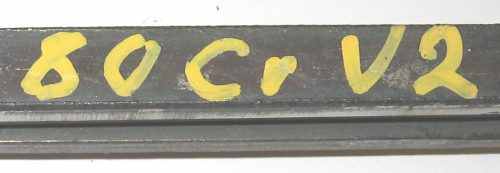80CrV2 steel is a time-honored, high-carbon tool steel renowned for its superior properties. Designed with precision, it contains chromium and vanadium elements in optimal proportions, elevating the strength and hardness of the steel’s crystalline matrix.
“Notably, vanadium plays a pivotal role in creating resilient carbides at the molecular level of the cutting edge, ensuring exceptional edge retention.“
This makes 80CrV2 steel a go-to choice for applications that demand both toughness and longevity.

Chemical Composition of 80CrV2 Knife Steel
The chemical composition of 80CrV2 steel plays a crucial role in determining its properties and performance. Here is an overview of its key elements:
| Element | Chemical Composition Range |
|---|---|
| Carbon (C) | 0.75% – 0.85% |
| Chromium (Cr) | 0.40% – 0.60% |
| Vanadium (V) | 0.15% – 0.30% |
| Manganese (Mn) | 0.20% – 0.40% |
| Silicon (Si) | 0.15% – 0.30% |
| Phosphorus (P) | Max 0.025% |
| Sulfur (S) | Max 0.025% |
- Carbon (C): The carbon content in 80CrV2 steel is typically around 0.75% to 0.85%. Carbon contributes to the steel’s hardness and strength, making it suitable for heavy-duty applications.
- Chromium (Cr): With a chromium content of approximately 0.40% to 0.60%, 80CrV2 steel gains enhanced resistance to wear and corrosion. While it does not classify as a true stainless steel, the addition of chromium helps improve its overall durability.
- Vanadium (V): Vanadium is a vital alloying element in 80CrV2 steel, usually ranging from 0.15% to 0.30%. It significantly enhances the steel’s toughness, impact resistance, and edge retention. Vanadium forms stable carbides, contributing to the blade’s ability to maintain a sharp edge over extended periods.
Mechanical Properties of 80CrV2 Knife Steel
The mechanical properties of 80CrV2 steel are a testament to its exceptional performance capabilities.
| Property | Typical Value |
|---|---|
| Hardness (HRC) | 58 – 60 |
| Yield Strength | 1,600 – 1,800 MPa |
| Tensile Strength | 2,000 – 2,200 MPa |
| Toughness | Excellent |
| Melting Point | Approximately 1,430°C (2,606°F) |
| Density | 7.8 g/cm³ |
| Thermal Expansion | 10.8 x 10^-6 /°C |
Here are the notable characteristics:
- Hardness: When properly heat treated, 80CrV2 steel can achieve a hardness level of around 58-60 HRC (Rockwell Hardness Scale). This hardness ensures excellent edge retention and resistance to deformation, even under demanding conditions.
- Toughness: Known for its remarkable toughness, 80CrV2 steel can withstand heavy impacts and stress without fracturing or chipping easily. This property makes it ideal for applications that require durability and resistance to breakage.
- Wear Resistance: The combination of high carbon content and vanadium in 80CrV2 steel imparts excellent wear resistance. It can withstand prolonged use without significant loss of sharpness, ensuring the longevity of the cutting edge.
Equivalent Materials to 80CrV2 Knife Steel
While 80CrV2 steel is a distinct composition, there are some equivalent materials that share similar properties. These alternatives can be useful for knifemakers who may have difficulty sourcing 80CrV2. Here are a few examples:
- O-1 Tool Steel: O-1 is a popular choice for knifemakers due to its high carbon content (around 0.85% to 1.00%) and excellent wear resistance. It shares similarities with 80CrV2 in terms of toughness, edge retention, and ease of heat treatment.
- A-2 Tool Steel: A-2 steel contains chromium (around 5%) and vanadium (around 0.20%), similar to 80CrV2. It offers good toughness, wear resistance, and machinability, making it a viable alternative for certain applications.
- D2 Tool Steel: D2 steel is known for its high wear resistance and excellent edge retention. It contains chromium (around 12%) and vanadium (around 0.90%), making it comparable to 80CrV2 in terms of performance.
Expert Insight
Daniel Winkler, a distinguished ABS master bladesmith and the visionary behind Winkler Knives, swears by the remarkable performance of 80CrV2 steel in his creations.
He highlights the steel’s exceptional hardness and its ability to withstand rigorous heat treatment while remaining serviceable in the field. The sweet spot that 80CrV2 occupies in terms of hardness and toughness results in a blade with unparalleled lateral strength, shock resistance, and wear resistance.
In fact, Winkler’s tests have shown that 80CrV2 performs on par with S7 steel in shock resistance, while outshining it in terms of edge retention. For Winkler, a knife’s true value lies not only in its ability to hold an edge but also in its resilience and ease of sharpening.
Optimal Heat Treatment
Winkler employs a salt-based heat-treating method, which facilitates consistent temperatures and prevents carbon loss, resulting in superior blade performance.
Additionally, he meticulously heat treats the blade stock after grinding, optimizing the steel’s properties for outstanding performance and durability in the field.
Maintenance and Rust Prevention
While 80CrV2 steel contains chromium, it does not possess high enough quantities to be classified as a true stainless steel. Consequently, proper maintenance is crucial to prevent rust and oxidation.
Winkler addresses this by utilizing a Caswell finish, which not only enhances the blade’s appearance with a dark matte finish but also provides an effective barrier against oxidation. Regular cleaning, sharpening, and oiling are essential for the longevity and optimal performance of 80CrV2 knives.
Other Advocates of 80CrV2 Steel
Apart from Winkler Knives, other renowned knife makers such as RMJ Tactical and Varusteleka have embraced the exceptional properties of 80CrV2 steel. Its unparalleled toughness and hardness make it a preferred choice for a wide range of applications.
However, it’s worth noting that Winkler remains open to exploring even better steel options, always seeking to elevate his craft.
